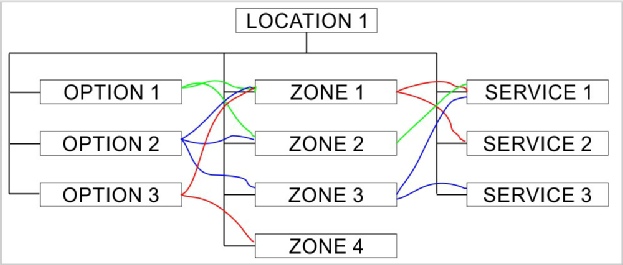2. Optimization of Lightning Protection design
A logical sequence for optimizing the project using the complete risk evaluation
1. Evaluate the risks considering, at first, the full structure as a unique zone, with no external protection, no surge protectors, no safety measures.
We do this so we can get a “zero level” to compare to; of course on a place with a reasonable density of lightning incidence, this initial risk will be well over the safety limit, the intention is to know how much over it is, which parts or the structure offers more risk and what are the main risk components.
For that step, we’ll need several information, like structure data (dimensions, type of construction, occupation and use), the service lines (typically, but not limited to, energy and telecommunications) connected to the structure and their conditions (if it’s aerial or buried, if has bounding, if the line forms loops) and also if the structure presents some clear separations of areas (like offices and industry process).
2. Zone division (not for the NFPA)
The international standard IEC 62305-2:2010 and some derivatives (like the Brazilian NBR 5419:2015) allows the division of the location in separate zones; the idea is to avoid expensive protections in areas with little exposure or occupancy and focus the protection efforts on critical areas.
Usually, 2, 3 or 4 zones is enough, although the software Atmos Plus X1 allows up to 16 zones - this is necessary to have several alternatives to build options of design and compare them - for example, you can define two zones on the same area, but with different protections, then you use each of these zones on different project Options.
3. Service lines
On most commercial and residential structures, there are lines of energy and telecommunication but, in industries, metallic piping lines (water, gas, vapor, …) can also offer danger to buildings and process installations.
With external lines - energy and telecommunication companies - usually you don’t have much control on the cable used or if it’s buried or not, but it’s possible to install surge protection devices (SPD), bonding when possible and choosing routes without loops.
4. Project Options
Currently, Atmos Plus X1 offer 6 Options of projects - combinations of zones, service lines and external protection - for design and compare of costs and installation time; if Atmos users find it necessary, we can easily increase this number but, for now, we think 6 is a good compromise between power and use of engineering hours.
Each Location (structure or area) can have multiple Zones and multiple Service lines; then you build Options using Zones that are connected to Service lines:
See also: examples and documentation of software Atmos
1. New edition 2017 of USA standard NFPA 780
Software Atmos Plus X1.2 includes the risk assessment according with the new edition, although keeping the 2014 calculations for compatibility with recent projects.
Some parameters from the influence areas have been modified for greater compatibility with international standard IEC 62305-2 (there’s still a small difference); it’s not necessary to enter the service line height (for aerial lines) or soil resistivity (buried ones).
Next updates of version X1.2 will add the dimensioning of LPS for solar energy installations, eolic turbines, boats and others that are covered on NFPA 780 but not on IEC 62305 and others.
Users with active contract of Atmos are already receiving the new update. Buy now your Atmos Plus X1.2 license and get one year (renewable annually) of upgrades and support!
Need simple grounding grid for Lightning Protection? Get our “Combo 1” which includes Atmos Plus X1.2 and TecAt LE 6 - or get Combos 2 or 3 for designing complex grids on multi-layer soil, including substation voltages (TecAt Plus on Combo 3 only).



